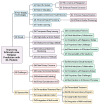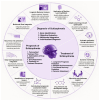A CNN-Transformer Fusion Model for Proactive Detection of Schizophrenia Relapse from EEG Signals
- PMID: 40564457
- PMCID: PMC12189536
- DOI: 10.3390/bioengineering12060641
A CNN-Transformer Fusion Model for Proactive Detection of Schizophrenia Relapse from EEG Signals
Abstract
Proactively detecting schizophrenia relapse remains a critical challenge in psychiatric care, where traditional predictive models often fail to capture the complex neurophysiological and behavioral dynamics preceding recurrence. Existing methods typically rely on shallow architectures or unimodal data sources, resulting in limited sensitivity-particularly in the early stages of relapse. In this study, we propose a CNN-Transformer fusion model that leverages the complementary strengths of Convolutional Neural Networks (CNNs) and Transformer-based architectures to process electroencephalogram (EEG) signals enriched with clinical and sentiment-derived features. This hybrid framework enables joint spatial-temporal modeling of relapse indicators, allowing for a more nuanced and patient-specific analysis. Unlike previous approaches, our model incorporates a multi-resource data fusion pipeline, improving robustness, interpretability, and clinical relevance. Experimental evaluations demonstrate a superior prediction accuracy of 97%, with notable improvements in recall and F1-score compared to leading baselines. Moreover, the model significantly reduces false negatives, a crucial factor for timely therapeutic intervention. By addressing the limitations of unimodal and superficial prediction strategies, this framework lays the groundwork for scalable, real-world applications in continuous mental health monitoring and personalized relapse prevention.
Keywords: personalized relapse prevention; robustness; schizophrenia disorder; transformer model; unimodal data.
Conflict of interest statement
The authors declare that they have no conflicts of interest.
Figures







Similar articles
-
Multivariate multi-horizon time-series forecasting for real-time patient monitoring based on cascaded fine tuning of attention-based models.Comput Biol Med. 2025 Aug;194:110406. doi: 10.1016/j.compbiomed.2025.110406. Epub 2025 Jun 10. Comput Biol Med. 2025. PMID: 40499368
-
Trajectory-Ordered Objectives for Self-Supervised Representation Learning of Temporal Healthcare Data Using Transformers: Model Development and Evaluation Study.JMIR Med Inform. 2025 Jun 4;13:e68138. doi: 10.2196/68138. JMIR Med Inform. 2025. PMID: 40465350 Free PMC article.
-
DeepECG-Net: a hybrid transformer-based deep learning model for real-time ECG anomaly detection.Sci Rep. 2025 Jul 1;15(1):20714. doi: 10.1038/s41598-025-07781-1. Sci Rep. 2025. PMID: 40595316 Free PMC article.
-
Perceptions and experiences of the prevention, detection, and management of postpartum haemorrhage: a qualitative evidence synthesis.Cochrane Database Syst Rev. 2023 Nov 27;11(11):CD013795. doi: 10.1002/14651858.CD013795.pub2. Cochrane Database Syst Rev. 2023. PMID: 38009552 Free PMC article.
-
Early intervention for psychosis.Cochrane Database Syst Rev. 2006 Oct 18;(4):CD004718. doi: 10.1002/14651858.CD004718.pub2. Cochrane Database Syst Rev. 2006. Update in: Cochrane Database Syst Rev. 2011 Jun 15;(6):CD004718. doi: 10.1002/14651858.CD004718.pub3. PMID: 17054213 Updated.
References
-
- Ranjan R., Sahana B.C., Bhandari A.K. Deep learning models for diagnosis of schizophrenia using EEG signals: Emerging trends, challenges, and prospects. Arch. Comput. Methods Eng. 2024;31:2345–2384. doi: 10.1007/s11831-023-10047-6. - DOI
-
- Amleshi R.S., Ilaghi M., Rezaei M., Zangiabadian M., Rezazadeh H., Wegener G., Arjmand S. Predictive utility of artificial intelligence on schizophrenia treatment outcomes: A systematic review and meta-analysis. Neurosci.-Obehavioral Rev. 2025;169:105968. doi: 10.1016/j.neubiorev.2024.105968. - DOI - PubMed
Grants and funding
LinkOut - more resources
Full Text Sources

